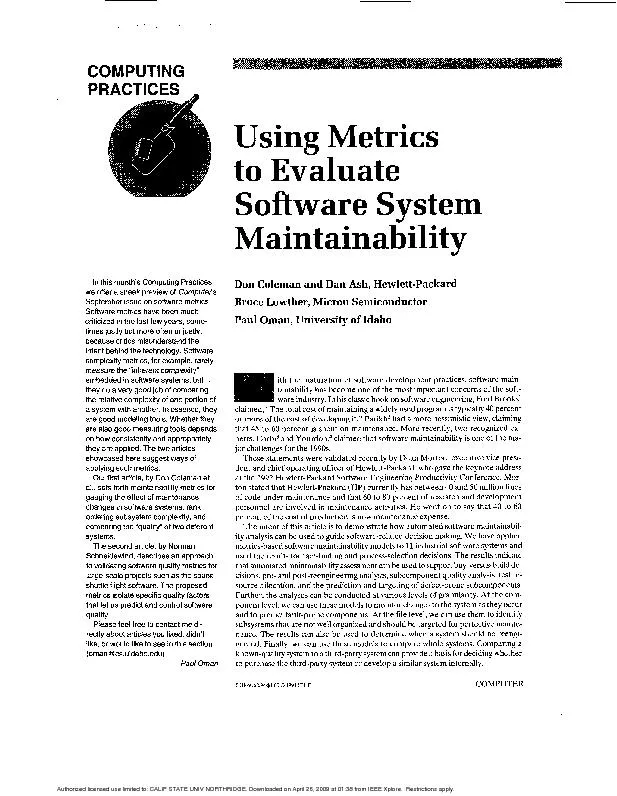/


software main tainability as the source gression analysis as a tool relationship between software complexity measure as a tistical technique reduce collinear between commonly construct regression ID: 375319
Download Pdf The PPT/PDF document "studies in metrics maintainability and q..." is the property of its rightful owner. Permission is granted to download and print the materials on this web site for personal, non-commercial use only, and to display it on your personal computer provided you do not modify the materials and that you retain all copyright notices contained in the materials. By downloading content from our website, you accept the terms of this agreement.
studies in metrics maintainability and quality assessment demonstrated that characteristics, history, associated en- all useful in measuring quality and maintainability characteristics can software maintainability assessment mod- then be industrial software systems. Successful models should identify measure what as important com- software maintainability. We recently analyzed software metrics. derivation, and validation been documented else- where.7 Only presented here: software main- tainability as the source gression analysis as a tool relationship between software complexity measure as a tistical technique reduce collinear- between commonly construct regression wherein metrics are or- are then models indicate tainability scores from calculations based on simple (existing) metrics. All and the managers in spring and summer it was decided hierarchical multidimensional assess- polynomial regression models would as simple mechanisms for maintainability ment that a variety wanted quick, easy-to-calculate could use following subsections explain were applied sional assessment model. HP’s software maintainability assessment system based hierarchical organiza- particular type maintainability prob- and Hagemeister6 have gested a hierarchical model characteristics pertaining characteristics pertaining dataflow techniques. naming, and includes characteristics typographic layout, and commenting can easily each di- mension’s characteristics. Once the met- have been defined andlor an “index each di- mension can metrics. Finally, sion scores can for a total maintainability index used existing metrics deviation from acceptable ranges Most metrics have an optimum range within which method called weight and trigger-point-range analysis maintainability by cal- a “degree fit” from a table acceptable metric ric value falls outside a deviation component’s contribution optimum range range for values falling below and above serve as what would as poor measured average value lies acceptable range, point range the bounds apply a proportional deviation, can run percent (the maximum penalty). by multiplying culated deviation by weighted value be- zero and one, combined based that the ability is able); they then reduced deviation percentage each metric. mension maintainability is calculated overall maintainability index the three dimensions. Multi- the three dimensions’ maintainabil- ity gives averaging does, maintenance effort, the entire was calibrated against gineers’ subjective systems, as quality assessment in- maintainability in- with 100 excellent maintainability. Polynomial assessment sion analysis is a statistical predicting values one or more response from a software maintainability create a as a metric attributes. We have used this technique develop a set mial maintainability assessment models were developed as software maintainability assessment calculated from ex- isting metrics. Since these models intended for use by tioners “in models were engineers’ subjec- software as abridged version software quality assessment ables used in models were variable was regression models were constructed in an attempt simple models lated from tools and generic enough software systems. research trend metrics, all Halstead‘s volume effort metrics best predictors for the most applicable was polynomial based stead’s effort metric and on suring extended cyclomatic complexity, and number where aveE, aveLOC, and average effort, extended average lines code, and number Preliminary results indicated large comment blocks, especially small modules, un- duly inflated resulting maintainabil- rectify this, aveCM component was placed limit its con- a maximum value Also, because has been much dis- stead’s effort a nonde- creasing function under using Halstead’s volume final four-metric polynomial work is This polynomial has been compared dation data. maintainability model only useful can provide developers and maintainers in industrial setting more information about the the data models consisted systems provided by Packard and Defense show how models can aid software maintainers lowing subsections real and unaltered, proprietary information been removed. maintenance changes. several years software maintenance, systems the number in entropy, prelpostanalysis can ensure that tem does after each mainte- nance modification. exemplify this, an subsystem, written in C for Once the modification was modified subsystem was analyzed by an overall analysis maintainability index in that the subsystem was essentially unchanged (a 0.4 percent increase) tually increased branches were engineer denied that creased, a visual inspection code revealed had, in been added original version ule Function-F, shown in section checks, while modified version (Throughout this discussion, function names have been Hewlett-Packard pro- contains a module-by-module comparison of pre- and post-test into four demonstrate the table contains modules that modified during second section contains slightly modified section contains have been and re- named. (The modules by visually inspecting identify any reused used in pretest system.) tion contains modules module in system. (Visual the code post-test components contained reused code from the pretest but they an area program where subsystem was ing in new subsystem This type can provide about the target example, section relatively high these components remain for a reusability library. second section have not first section. generally lower than those in the section, and they have percent from the Comparing pre- how much maintenance Pretest Post-test Change 15.00 15.4 maintainability index postanalysis results. Post-test Analysis 89.00 3.2 Authorized licensed use limited to: CALIF STATE UNIV NORTHRIDGE. Downloaded on April 26, 2009 at 01:38 from IEEE Xplore. Restrictions apply. Authorized licensed use limited to: CALIF STATE UNIV NORTHRIDGE. Downloaded on April 26, 2009 at 01:38 from IEEE Xplore. Restrictions apply.